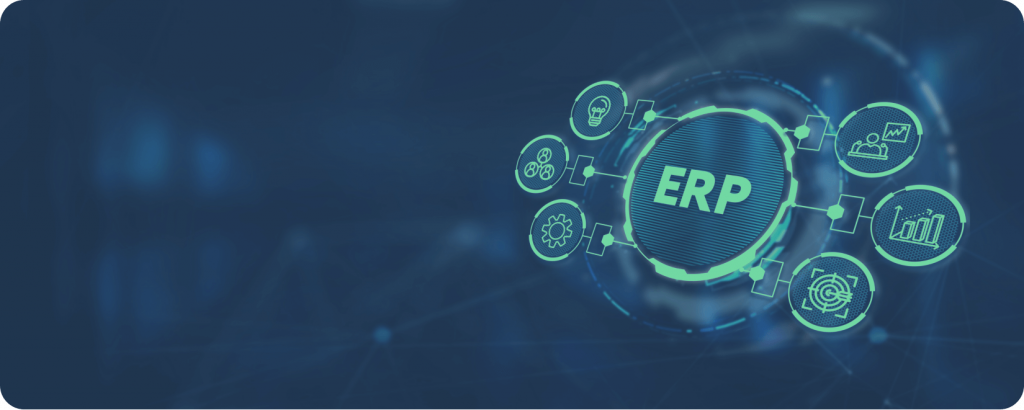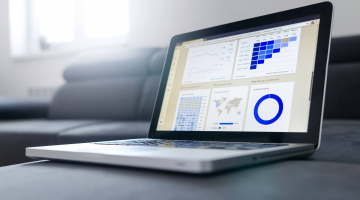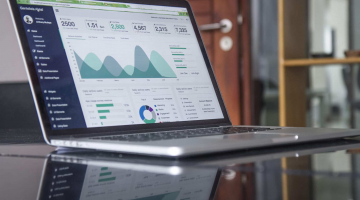

All you should know about a financial module in ERP
Enterprise resource planning in finance is a software platform that collects information and crafts reports: general ledgers, fixed assets, receivables, payables, cash flows, etc. What does ERP stand for in finance? A financial module of an ERP system gives any business or corporation the tools for tracking all the data within one or several companies, transactions, languages, and currencies.
Read our full guide on ERP software development.
Finance module in ERP software — key features and components
Automating the solutions for the back-office routine improves the performance of any company. ERP is a platform that you can rely on when you access any data in real time. It means that any updates and changes are available a moment after they have been finished.
So, what is ERP in finance? In general, it’s a powerful solution for managing the financial part of the business and integrating it with other units. You can integrate it with production, sales, shipping, management, etc. All transactions are available from any device and in any location. No handwork and no mistakes in making the calculations. Complete transparency and everlasting records of the transactions make a financial module a valuable tool.
Need professional ERP implementation services? Apply for a free consultation!
ERP finance module features
Features may vary for different ERP solutions. Therefore, it’s good if you develop a custom platform with the financial module — you will get a great opportunity to implement only those features that your business needs. If you pick up a ready solution, you will be limited in several features, or you will have to pay for those you don’t actually need.
Implementing essential features into the ERP system will let any organization keep pace with the changing market situation around them. It’s much easier to become and remain a market leader when all the key processes are automated, and the staff can focus on increasing the revenue rather than on administrative tasks.
Let’s take a close look at the most common features of ERP systems.
Client database
You know all the information about your clients and store it in one location. Besides, you can collect data about financial transactions, balance sheets, and personal facts. Also, you can grant your staff access to this information, which will be available at any time of the day or night.
Accounting system
No more tons of paper waste. ERP finance and accounting modules will help you turn all the paperwork into online reports and sheets available for anyone with access. All the processes become visible and transparent.
Asset management
You get a simple but powerful tool for monitoring the assets and their state. Moreover, you will see the depreciation in real time if it ever happens. You will also receive advanced reports that are formed in a few seconds.
Financial analytics
You will see all the dashboards in real-time with receivables and payables data, various types of reports, and other important data units. Everything you see in finance modules in ERP is displayed in a user-friendly way with visuals.
Payment systems
If you provide clients with various payment systems, it will be easy to manage and make any updates. You will also make all the transactions more secure.
Forecasting
The ERP financial system module will provide you with accurate forecasts that are based on reports and the current situation in your company. There will be comprehensive algorithms that will save you hours of work.
ERP finance system: Other features
You will have simple billing and invoice management systems for any currency you need, keeping all the financial and operational metrics in one place. If you choose a custom ERP development service, you will be able to decide what kind of features a financial module of an ERP system will have.
So, how can you benefit from the features of ERP in finance?
- Improved performance and productivity
- Real-time dashboards and reports
- No mistakes in calculations
- Advanced financial forecasting
- Advanced control over operations
ERP finance module tutorial
Here’s a guide on how to use the financial module in an ERP system. You should mind that this guide is not complete, and you can have another set of actions for a custom ERP platform.
A financial module should be present in every ERP platform if an organization has at least one transaction during its lifetime. In short, it’s good for every startup and business.
The key functions of a financial module are as follows:
- GL – General Ledger, together with accountant management
- AP – Account Payables
- AR – Account Receivables
- AM – Asset Management
- CM – Cash Management
What can you manage with the ERP financial module?
- Communication between your company and all the vendors, suppliers, manufacturers, and service providers with the help of payables.
- Management of all the revenue received from the clients with the help of a general ledger.
- Monitoring of all the transactions through the bank with the help of the cash management tier.
- Evaluate, record, track, and manage the assets inside the whole organization with the help of asset management and general ledger tiers.
- Management and evaluation of all the financial frameworks with the help of the general ledger tier.
What you get with ERP finance management is an advanced picture of what’s going on in your company in real-time. You have a clear understanding of every process, transaction, and overall situation. If the module is set the right way, you will see your progress toward your business goals.
General ledger
What you get with a reliable financial module is complete control over the information and its integration with other units in the company. The core of the module is GL — a general ledger. You can easily integrate it with different operations and processes in your company, like logistics, accounting, management of cash flows, and so on. What you have is a central node with all the important data for reports and real-time supervision.
Here are the key features of the GL tier
- Easy integration with logistics
- Simple setup (if you have a custom ERP system)
- A year and another period closing
Here’s what you can do with the GL tier
- Invoicing and everything that is related to payable accounts
- Adjusting invoices for receivables and related items
- Payment information about cash flows is sent to GL
- Accounting the costs
- Managing assets depreciation
One of the key reasons to choose a custom ERP system development service is a chance to get an easy way to create and update accounts in the financial ERP systems. You will need to have a good structure of all the accounts and the possibility to classify them and divide them into categories. It’s important if you have this option, as categorizing hundreds of accounts manually may turn into a nightmare.
You will also choose how the accounts are displayed and organized in a module ERP. It’s good to think about the structure from the point of view of management. One of the common variants is a vertical view. One more feature that matters is the type of transaction. It should be easy to define each transaction category, like sales invoices, cash, journal vouchers, and corrections.
Want to develop a custom ERP? Check how we can help you!
Integration of GL with logistics
Let’s take a look at the example of integrating the GL tier with the logistics module:
- Purchase. Creating an order, transporting the materials, checking and approving the quality of materials, and invoicing.
- Sales. Creating a sale order, its release to the warehouse, handing out the material, and invoicing.
- Counting. Crafting orders for cycle counts, approving the order, and processing it.
- Subcontract orders. Creating an order for production, creating a subcontract purchase, making an issue for the subcontractor, issuing the inventory, receiving the order, completing the order, and closing it.
Closing a period or closing a year is mandatory for auditing, making financial corrections, reconciliation, or correcting the ledger history.
Payables and receivables
These are two essential components of a financial module within an ERP system. AP component is responsible for the input provided to the company in the form of services or goods. AR is responsible for the financial interaction with clients that use the company’s outputs. These components keep the information about debtors and creditors and various sub-ledgers that comprise accounts for control, currency fluctuation, etc.
Account payables
With a custom ERP system, you can quickly register all new invoices. You will also track and authorize all the incoming invoices. You will have a user-friendly form for approving invoices, or you can have an automated generation of invoices depending on the situation. And you will also have a classification for accounts.
Account receivables
A simple way to track invoices for customers you are waiting for payments from. Here you will also have a classification of accounts. You may have a credit management system that works in real-time. You may add reports with the analysis, statements about the customers, and interest for postponed payments. A key moment here is reminders about unpaid invoices.
Asset management
Managing fixed assets is one of the key things that is performed by the financial module. Here you have a register for the assets with all the transactions, solving fixed asset depreciation for the financial reports and asset revaluation. The key functions of the AM are investment and disposal, depreciation defined by the user methods, regular revaluations of the fixed assets, and insurance information.
Investment and disposal method
You need it when an organization is acquiring a new asset. A new investment transaction comes out when the payment occurs within the accounts payables for asset acquisition. The result of the process is added to the general ledger. This asset is recorded in the asset management system, and it’s connected to the depreciation method. It’s now ready for regular and repeatable depreciation and revaluation. So, in a case when the asset is sold or discarded, a new disposal transaction comes out to generate a sales invoice in AR and add the transaction in a GL.
Users’ defined depreciation method
It is a handy and flexible means for maintaining the depreciation cost. This method lets the system think of depreciation as a fixed amount, a percentage of the purchase, or the number of years within one operation. You can use this method for the whole company or for some specific groups of assets.
Periodic revaluation of a fixed asset
The revaluation amount is usually calculated during the year period closing, and the result of this calculation is stored in the general ledger. It’s a positive correction of the asset book value, and it is connected with the indices defined by the users.
Budget
This component comprises creating, maintaining, and supervising the budget amount with the help of ledger accounts. You can plan the budget for the next year and divide it into periods.
Cash management
This component comprises processing and the analysis of all transactions via the banks, analyzing invoices and receipts, and other payments that are related to the cash flow. You can see all the transactions for a specific period of time and see if you have reached your financial goals or not.
If you need to integrate some modules into an existing ERP system, we are here to help you. Check our system integration services.
ERP finance module case study
We have been working on the development of ERP solutions for finance for a few years. And we can present a few ideas of how we cope with the tasks.
Case #1
A team of developers architected and developed a SaaS application from scratch according to the company’s needs. The app runs a series of analytics, calculations, procedures, and visualizations on financial information and sales transactions. It allows users to instantly view their current tax obligations and requirements, including trends, variance, and proportional taxes. It also runs a series of automated tests that search for potential errors and incorrect conclusions.
Technology used: Node.js, Angular 2 – 5, MongoDB, and Azure Cloud.
Case #2
A team of developers designed and implemented a new financial management system, enabling timely consolidated reporting of financial results that are understandable, accurate, and easily accessible. The system provides the following features:
- Financial reporting
- Investment reporting
- Report batching
- Investment dashboards
- Trend analysis dashboard
- Automated monthly investment journal entry
- User security and system administration
Technology used: ASP.NET, Angular 2 – 5, MS SQL, and Azure Cloud.
Case #3
We provided one bank with a team of professionals who helped the bank’s directors define the best features for their corporate banking application. After that, DICEUS assembled a development team that started implementing a system in October 2018.
These features of the application imply:
- Client database module
- Module with storage of documents in e-form
- Accounts management module
- Payments module
- Statement module
- Loans module
- Deposits module
- Currency exchange module
- Payroll projects module
Technology used: Java Enterprise, PostgreSQL, Angular 2-5, Swift 3-4, Java for Android/Kotlin.
More cases to discover:
SAP ERP audit for Palmers Textil
Enterprise resource planning tool for a transport company
ERP project for Total Image Group

ERP finance consultant
This section is for those who want to know everything about the financial module within an ERP system. So, we’ll guide you through the essential concepts of terminology, processes, and functionality. We act as financial consultants on this page.
The first thing to start with before you choose a solution for your company is understanding what you need. Think how much time you have from now to the moment when everything should be working fine. The time for implementation will influence the choice of the ERP platform. Another thing to consider is the number of functions you want to have in it.
And one more thing is the budget. A combination of these three things will guide you to the right decision. A custom ERP development service will give you a series of tools that you need right now, with the possibility to scale the system in the future. This will save both time and budget.
What is a work plan in an ERP system?
A work plan is an essential tool in an ERP system finance. It comprises task assigning, workflow management, and supervising other components. You will see where you are now and how far the deadlines are. An average workflow lasts from 6 to 12 months, but you can adjust its period according to the requirements of your organization.
This plan helps businesses to build strategies and see how efficient they are. There’s a plan that contains all the details and important information that influences the overall performance of the company. A work plan is defined for a project where you state the goals. You have a destination to get to, and you have a set of steps that you and your team have to take.
The next step that comes after defining the goals is organizing teams and setting tasks for them. You may have various types of teams with completely different ways to perform their tasks. Every team should have a leader who will manage the workflow and employee relationships.
The next steps comprise defining the roadmap and the budget. Time is money, so there should be tangible milestones that will let you evaluate the progress and what problems you face on your way to the goals. It’s good to define the budget for each time and for each milestone. These subdivisions will let you control the expenses and predict any possible blowups.
What is ERP system software?
ERP is good for both small and big businesses. Most of the solutions are scalable, so you can expand the system together with the company’s growth. In simple words, ERP is a regulated flow of various operations inside one company and outside it, in one department and between several of them. You can get reports on what is happening in the company in real-time. All these reports are automated and absolutely accurate. There’s no risk that the software will make a mistake in calculations.
What you can see in the reports is information about inventory, production, and the way the orders are processed. Some ERP solutions are in the form of modules. You can regulate access to one or all modules for a department or for some individuals. It will simplify the workflow of each team as employees will not be overloaded with tons of various data. Thus, ERP is a good means to manage the company’s spending. You can see all the transactions, reports about the spending of each department and so on.
Short history
ERP first appeared in the 90s for manufacturers. There was a need to manage inventory and supply chains. What we have today is the support for the back-office part of the workflow, such as inventory management. There’s also the front part, like solving accounting tasks, customer service management, etc.
ERP tiers
There are several tiers of ERP software that are responsible for different types of tasks. For example, the highest tier can be used by the company managers to see and analyze the data related to the overall functioning of the business, including all the branches worldwide. A lower level will be responsible for some specific pieces of information for some departments or individuals.
What are ERP tools?
Here are the most commonly used tools in ERP software.
Information storage
All the data is in one place, and it can be accessed from any department of the company. You can find available solutions like Oracle, Sybase, and Apache Derby or order a customized solution from DICEUS. We can also mention Content Management Systems (CMS) here as well.
Depending on the tasks, there will be a different choice of database. Oracle or MySQL may be a good fit for a manufacturing company, while a CMS platform will be just fine for an online content company. Data storage can be local, remote, or cloud.
Limited access and permission control
If we take a manufacturing company, we will see that every department sees only their part of the work. For example, an item has been manufactured, and it’s ready for sale. The sales department will see this and mark the item as ready for sale. Once this item is sold, the status will be automatically updated, and information will be transferred to the logistics department.
Management of the workflow
A workflow is a series of tasks that need to be solved. It may comprise collecting new information, recording, and storing it. There should be limited access to the part of an ERP system to prevent any changes in the information or any updates. You can choose one of the available solutions like Inceptico DMC, Agiloft Workflow, or any other.
Reporting
ERP software collects and processes information. If a system is developed correctly, it will display only accurate data. It’s good to have a solution that provides you with real-time data that is visually attractive. Here we mean charts, diagrams, and so on.
Each ERP in financial services may have its own set of tools and features that may vary. If you pick up a variant of a customized solution, you will have a few benefits. You will add as many modules as you need, and you won’t pay more for the unimportant features and modules.
Conclusion
Developing an ERP system with a reliable financial module is a tough and complicated task. As a team of experienced developers, we can state that this requires a thorough analysis of the company workflow and tasks that need to be automated. As a result, you get a comprehensive solution that will let you focus on business goals and delegate all the routines to automated software.
Here at DICEUS, we have gained enough expertise to use the latest technology for building new projects and upgrading the current ones. If you’re looking for a software development partner that will help you solve your business needs, we’re always here to find the most suitable solutions for your finance ERP software.
Learn more about DICEUS.
FAQ
What does ERP stand for?
ERP means enterprise resource planning which is simultaneously a name for the process and systems used to maintain this process. Usually, such systems consist of several modules like sales and marketing, accounting, inventory management, reporting, etc. ERP systems can be custom-built or ready-made solutions.
What is ERP in finance?
ERP in finance is a software solution used for finance operations. These may contain all modules necessary to manage orders, invoices, payables, receivables, etc.
Why are ERP finance modules important?
ERP finance modules matter because they help manage all internal and external financial flows and data inside the organization. For finance modules to bring the utmost value, it is better to build a custom ERP system. Only then will your system contain all necessary functionalities that correspond to your business processes and communicate effectively with each other.





